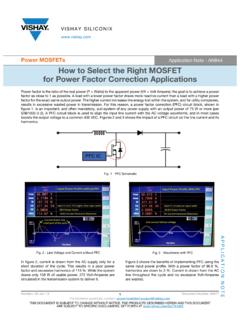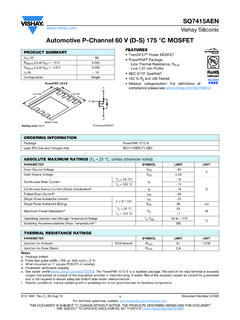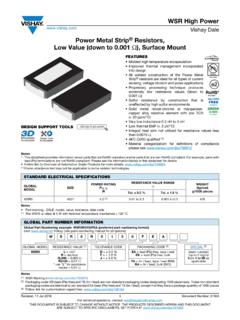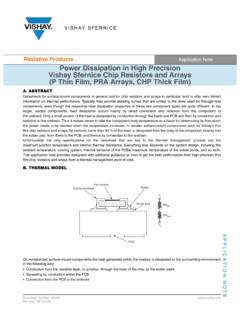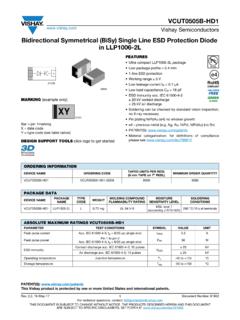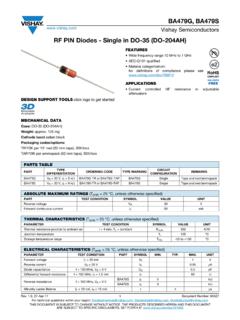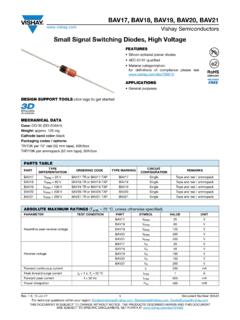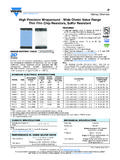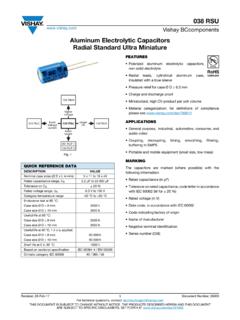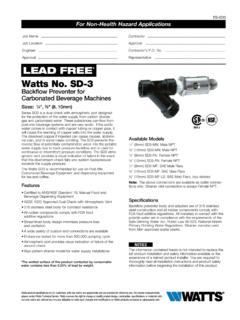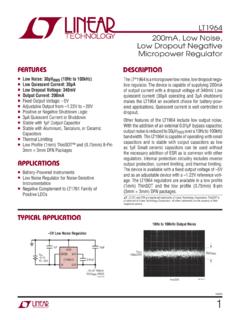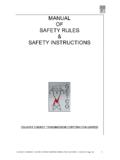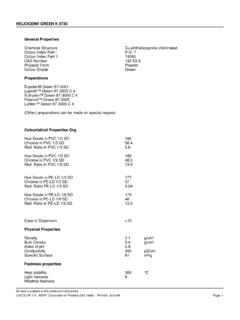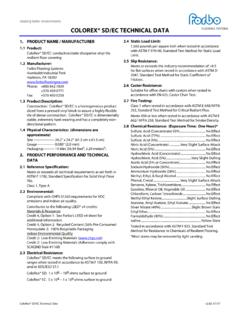Transcription of Infrared Transceiver, 9.6 kbit/s to 115.2 kbit/s (SIR)
1 Semiconductors Rev. , 02-Jul-20181 Document Number: 84672 For technical questions within your region: DOCUMENT IS SUBJECT TO CHANGE WITHOUT NOTICE. THE PRODUCTS DESCRIBED HEREIN AND THIS DOCUMENTARE SUBJECT TO SPECIFIC DISCLAIMERS, SET FORTH AT transceiver , kbit/s to kbit/s (SIR)DESIGN SUPPORT TOOLSDESCRIPTIONThe TFBS4650 is one of the smallest IrDA compliant transceivers available. It supports data rates up to 115 kbit/s . The transceiver consists of a PIN photodiode, Infrared emitter, and control IC in a single Compliant with the IrDA physical layer IrPHY (low power specification, kbit/s to kbit/s ) Link distance: 30 cm/20 cm full 15 cone with standard or low power IrDA, respectively.
2 Emission intensity can be set by an external resistor to increase the range for extended low power spec to > 50 cm Typical transmission distance to standard device: 50 cm Small package (L x W x H in mm): x x Low current consumption 75 A idle at V Shutdown current 10 nA typical at 25 C Operates from V to V within specification over full temperature range from -25 C to +85 C Split power supply, emitter can be driven by a separate power supply not loading the regulated. pat. no. 6,157,476 Qualified for lead (Pb)-free and Sn/Pb processing (MSL4) Material categorization.
3 For definitions of compliance please see Mobile phone PDAs20206click logo to get startedAvailableModelsPRODUCT SUMMARYPART NUMBERDATA RATE( kbit/s )DIMENSIONSH x L x W(mm x mm x mm)LINK DISTANCE(m)OPERATING VOLTAGE(V)IDLE SUPPLY CURRENT(mA) x x to to TABLEPARTDESCRIPTIONQTY/REELTFBS4650-TR1 Oriented in carrier tape for side view surface mounting1000 pcsTFBS4650-TR3 Oriented in carrier tape for side view surface mounting2500 pcsTFBS4650-TR4 Oriented in carrier tape for side view surface mounting6000 pcsTFBS4650-TT3 Oriented in carrier tape for top view surface mounting2500 Semiconductors Rev. , 02-Jul-20182 Document Number: 84672 For technical questions within your region: DOCUMENT IS SUBJECT TO CHANGE WITHOUT NOTICE.
4 THE PRODUCTS DESCRIBED HEREIN AND THIS DOCUMENTARE SUBJECT TO SPECIFIC DISCLAIMERS, SET FORTH AT BLOCK DIAGRAMPINOUTTFBS4650, bottom viewweight gDefinitions:In the vishay transceiver datasheets the following nomenclature is used for defining the IrDA operating modes: SIR: kbit/s to kbit/s , equivalent to the basic serial Infrared standard with the physical layer version IrPhy MIR: 576 kbit/s to 1152 kbit/s FIR: 4 Mbit/s VFIR: 16 Mbit/sMIR and FIR were implemented with IrPhy , followed by IrPhy , adding the SIR low power standard. IrPhy extended the low power option to MIR and FIR and VFIR was added with IrPhy A new version of the standard in any case obsoletes the former DESCRIPTIONPIN NUMBERSYMBOLDESCRIPTIONI/OACTIVE1 IREDAIRED anode, connected via a current limiting resistor to VCC2.
5 A separate unregulated power supply can be used. 2 IREDCIRED cathode, do not connect for standard data input. Setting this input above the threshold turns on the transmitter. This input switches the IRED with the maximum transmit pulse width of about 100 output. Normally high, goes low for a defined pulse duration with the rising edge of the optical input signal. Output is a CMOS tri-state driver, which swings between ground and VCC. Receiver echoes transmitter Logic low at this input enables the receiver, enables the transmitter, and un-tri-states the receiver output. It must be driven high for shutting down the supply, V to V.
6 This pin provides power for the receiver and transmitter drive section. Connect VCC1 via an optional driverTXDSDGNDVCCIREDARXDTri-statedriver PDIREDASICIREDC19283 ComparatorModecontrolAmplifier19284 Pin 1 Pin Semiconductors Rev. , 02-Jul-20183 Document Number: 84672 For technical questions within your region: DOCUMENT IS SUBJECT TO CHANGE WITHOUT NOTICE. THE PRODUCTS DESCRIBED HEREIN AND THIS DOCUMENTARE SUBJECT TO SPECIFIC DISCLAIMERS, SET FORTH AT Reference point pin, ground unless otherwise noted Typical values are for DESIGN AID ONLY, not guaranteed nor subject to production testing(1)Sn/lead (Pb)-free soldering.
7 The product passed vishay s standard convection reflow profile soldering testNote vishay transceivers operating inside the absolute maximum ratings are classified as eye safe according the above tableABSOLUTE MAXIMUM RATINGSPARAMETERTEST voltage range, transceiver0 V < VCC2 < 6 voltage range, transmitter0 V < VCC1 < at RXDAll + voltage range, transmitter TXDI ndependent of VCC1 or currentsFor all pins,except IRED anode pin-40-40mAOutput sinking current--20mAPower dissipationPD--250mWJunction temperatureTJ--125 CAmbient temperature range (operating)Tamb-25-+85 CStorage temperature rangeTstg-40-+100 CSoldering temperature (1)See section Recommended Solder Profile --- CRepetitive pulse output current< 90 s, ton < 20 %IIRED (RP)--500mAAverage output current (transmitter)IIRED (DC)--100mAThermal resistance junction-to-ambientJESD51 RthJA-300-K/WEYE SAFETY INFORMATIONSTANDARDCLASSIFICATIONIEC/EN 60825-1 (2007-03), DIN EN 60825-1 (2008-05) SAFETY OF LASER PRODUCTS - Part 1.
8 Equipment classification and requirements , simplified methodClass 1 IEC 62471 (2006), CIE S009 (2002) Photobiological Safety of Lamps and Lamp Systems ExemptDIRECTIVE 2006/25/EC OF THE EUROPEAN PARLIAMENT AND OF THE COUNCIL of 5th April 2006 on the minimum health and safety requirements regarding the exposure of workers to risks arising from physical agents (artificial optical radiation) (19th individual directive within the meaning of article 16(1) of directive 89/391/EEC) Semiconductors Rev. , 02-Jul-20184 Document Number: 84672 For technical questions within your region: DOCUMENT IS SUBJECT TO CHANGE WITHOUT NOTICE.
9 THE PRODUCTS DESCRIBED HEREIN AND THIS DOCUMENTARE SUBJECT TO SPECIFIC DISCLAIMERS, SET FORTH AT Typical values are for design aid only, not guaranteed nor subject to production testingELECTRICAL CHARACTERISTICS (Tamb = 25 C, VCC = V to V unless otherwise noted)PARAMETERTEST voltage supply currentIdle, dark ambientSD = low (< V), Eeamb = 0 klx,Ee < 4 mW/m2- 25 C T + 85 C ICC-90130 AIdle, dark ambientSD = low (< V), Eeamb= 0 klx,Ee < 4 mW/m2T = + 25 CICC-75 - APeak supply current during transmissionSD = low, TXD = highIccpk-2 3mAShutdown supply current dark ambientSD = high (> VCC - V), T = 25 C, Ee = 0 klx AShutdown supply current, dark ambientSD = high (> VCC - V), - 25 C T + 85 CISD-- 1 AOperating temperature rangeTA-25-+85 CInput voltage low (TXD, SD) voltage highVCC = V to V VIHVCC - 6 VInput voltage threshold SDVCC = V to V voltage low VCC = V to VCLOAD = 15 x voltage high VCC = V to VCLOAD = 15 pFVOHVCC x + to VCC pull-up impedanceSD = VCC VCC = V to 5 VRRXD-500-k Input capacitance (TXD, SD)CI-- Semiconductors Rev.
10 , 02-Jul-20185 Document Number: 84672 For technical questions within your region: DOCUMENT IS SUBJECT TO CHANGE WITHOUT NOTICE. THE PRODUCTS DESCRIBED HEREIN AND THIS DOCUMENTARE SUBJECT TO SPECIFIC DISCLAIMERS, SET FORTH AT Typical values are for design aid only, not guaranteed nor subject to production testing(2)This parameter reflects the backlight test of the IrDA physical layer specification to guarantee immunity against light from fluorescent lamps.(3)IrDA sensitivity definition: minimum irradiance Ee in angular range, power per unit area. The receiver must meet the BER specification while the source is operating at the minimum intensity in angular range into the minimum half-angular range at the maximum link length(4)Maximum irradiance Ee in angular range, power per unit area.
